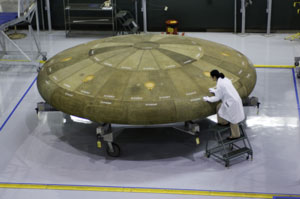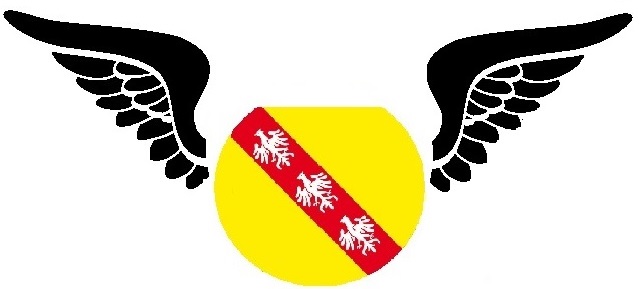Orbiting
trajectory
During
the propelled phase, the launcher follows a law of attitude which will
gradually bring it in the direction required for the injection of the
satellite.
During the flight, the trajectory is constantly recalculated
taking into account the trajectory actually followed by the launcher.
The departure is done vertically to cross the atmosphere as quickly as
possible and as the density of the atmosphere decreases, it will leave the
vertical direction which is the direction in which gravity is exercised.
The reduction of speed undergone by the rocket on a vertical
course is expressed by the formula 9,81 x t
Using the slingshot effect
The earth makes a complete turn on itself in 24 hours
V = 2 π
R cos (L) / 24
• R: Radius of the Earth in km (6378)
• L: Latitude of the point in degree
• t: Time in days
• V: Speed in km / h
At the poles, the speed of
rotation is zero. At the equator, it is
For Kourou, this speed is
For
For Baikonour of
That is why we throw more often towards the east and from a site placed
near the equator. To avoid that the rocket falls on inhabited areas it is
necessary to the west of the site an ocean or a desert. It is preferable that
this ocean or desert also open to the North or South for launching into polar
orbits.
Choice
of inclinations
The slingshot gain is only effective for a launch in equatorial orbit.
If the target orbit is inclined, this velocity will only be partly
useful (proportion determined by trigonometry).
For a polar orbit, it is useless, the latitude
of the launch site will be almost indifferent
If, the launch is retrograde (towards the west), the rotation of the
ground penalizes the shot because it is necessary to compensate this speed.
For a site far from the equator, it is best to choose an orbit whose
inclination is about the latitude of the site.
Orbiting can be done in two different ways depending on the target
injection point.
If the target orbit is low, passing close to the launch site, it is
possible to ignite all the stages one after the other.
If, on the other hand, the target orbit is high or if the orbital plane
is very far from the launch site, then ballistic phases are inserted during the
powered phase.
Ariane space
launches its satellites directly into the transfer orbit GTO (Geostationary
Transfer Orbit). Shots are fired from
For a GTO orbit, it is necessary to add to the satellite in addition to its
apogee engine, a perigee engine for injection.
Rocket
guidance
The first rockets were not guided: once launched, they followed a
ballistic trajectory.
This is the case for the last stages of some space launchers, for
rockets, and micro-rockets (amateur rockets, fireworks).
To achieve an objective, or to place a satellite in orbit, it is
necessary that this rocket is guided, that is to say that it can modify its
trajectory and control its roll.
Orders are obtained by a system of gyroscopes or by guidance from
the ground.
Aerodynamic guidance
Flaps with movable flap, (at least 3).
By turning the flap in one direction, a force is created in one direction or
the other, perpendicular to the axis of the rocket. This force turns it around
its center of gravity. Aerodynamic control also helps
control roll. This
system can only be used in the atmosphere.
Dans le cas d'un lanceur
multi-étage, ce n'est utilisable que pour le premier étage qui évolue dans
l'atmosphère.
Les missiles qui ne quittent pas
atmosphère emploient ce système, seul ou avec tuyère orientable.
Nozzle
flow deflection method
Sometimes the injection of liquid or gas into the nozzle is used to
deflect the flow of gas. If a stage has at least two nozzles, it is only to
steer them differently to have roll control.
If there is only one, we have the choice between 3 solutions:
-V verniers, small auxiliary engines
For liquid propellant engines, a small portion of the gases produced to
power the turbopump are used.
-Aerodynamic control (for a first floor).
- A system of valves on the flanks of the rocket.
Orbiting
A satellite revolves around a star with such a speed that the
centrifugal force compensates for its weight. It is therefore pseudo-isolated,
so its speed remains constant as long as it is out of the atmosphere.
The satellite is not weightless. He is even constantly falling, but
thanks to his speed, he falls and misses the Earth.
The speed given to a satellite
decreases with the altitude of this one:
The higher he is, the less he is subject to gravity. The speed of
orbiting is
|
GROUND DISTANCE |
CIRCULAR SPEED |
RUNTIME OF REVOLUTION |
|
|
7,86 km/s
|
1 h 28 |
|
|
7,75 km/s
|
1h 30
|
|
|
7,58 km/s
|
1h 36
|
|
|
7,04 km/s
|
2 h
|
|
|
6,15 km/s
|
3 h
|
|
|
5,59 km/s
|
4 h
|
|
|
4,88 km/s
|
6 h
|
|
|
3,87 km/s
|
12 h
|
|
|
3,07
km/s |
24 h
|
It is not easier to place a
satellite in a distant orbit than in a nearby orbit, since it requires less
speed.
The characteristic speed of an altitude of
The most economical way to place a satellite in an orbit far from the
Earth is the transfer.

Specialisations of the orbit
Whether elliptical or circular, an orbit is characterized by:
1 The period T (time for a revolution) which is calculated by the third
law of Kepler. This period T depends only on the
half-major axis. It will be 90 minutes for a satellite at
2 The altitude is in km.
3 The inclination to the equator. If the latter is close to 0 °, the
orbit is called equatorial, if it is close to 90 °, it is polar.
4 The apogee (highest point) the greatest distance to the earth
5 The perigee (the shortest distance)
6 The perigee argument: An angle between the apogee and perigee line
with the Equator plane (less than or equal to the inclination of the orbit). An
ellipse has two homes. An ellipse of string x and of foci A and B (x> AB) is
the set of points M such that MA + MB = x.
7 The precession of the apse line: The axis connecting apogee and
perigee (line of the apses) of an inclined elliptical orbit also turns around
the axis of the poles.
The orbit of a satellite will be circular only if its injection takes
place, on the one hand parallel to the ground, and on the other hand at the
right altitude for a given speed. If these conditions are not met, the orbit is
elliptical.
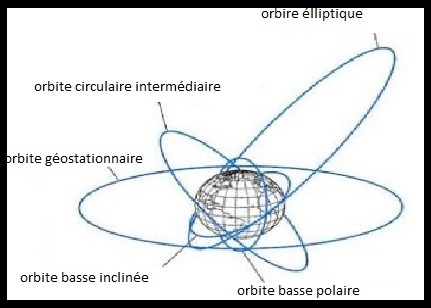
The
GEO orbit
The geosynchronous orbit has a period of revolution of 23 h 56 min 4s,
the sidereal period of rotation of the earth. According to the inclination of
this orbit, the satellite will describe "8" in the sky more or less
elongated according to the inclination.
The geostationary satellite has the property of remaining fixed with
respect to a ground observer. Its orbit is equatorial, circular and synchronous
with the rotation of the earth.
The third law of Kepler shows that the
altitude of such an orbit is
This type of orbit is used for telecommunication satellites and most
weather satellites.
To access it, the satellite is placed in an elliptical orbit whose apogee
is
For the satellite to remain well in its orbit, it is necessary to adjust
its trajectory which limits its lifespan to 7-10 years. Small control engines
make it possible to make corrections. The sun and moon also cause disturbances
of the order of 1 ° per year.
These satellites because of their altitude are almost permanently
outside the cone of shadow of the earth and thus benefit from constant
illumination. During the equinox period (March and September), they can
sometimes be plunged every day in the dark for periods not exceeding 72
minutes.
Orbit SSO
(Sun Synchonous Orbit) or sun-synchronous orbit.
The satellite in its orbit suffers disturbances due to the nearby land.
Since it is not spherical and its mass is not uniform, gravitational
variations disturb the trajectory of the satellite.
If we want the plane of the orbit to keep a constant orientation with
respect to the sun, we must rotate it a little less than 1 ° per day (360 ° /
365 days).
The satellite remains exposed to the sun, above the penumbra (evening /
morning). Some Earth observation satellites are placed in such orbits, and they
have always seen on a lit ground (with the light inclined, so shadows highlighting
the reliefs).
This illumination also benefits the solar panels of the satellite that
are constantly lit in the same way. Such a satellite placed on an orbit at
The transfer The transfer is a more complex spatial positioning
than the orbiting.
But a satellite rotating
around the Earth at
If at a point at this altitude, instead of
this speed of
With
When the satellite is at the apogee of its new
trajectory, at an altitude of
This remaining speed is:
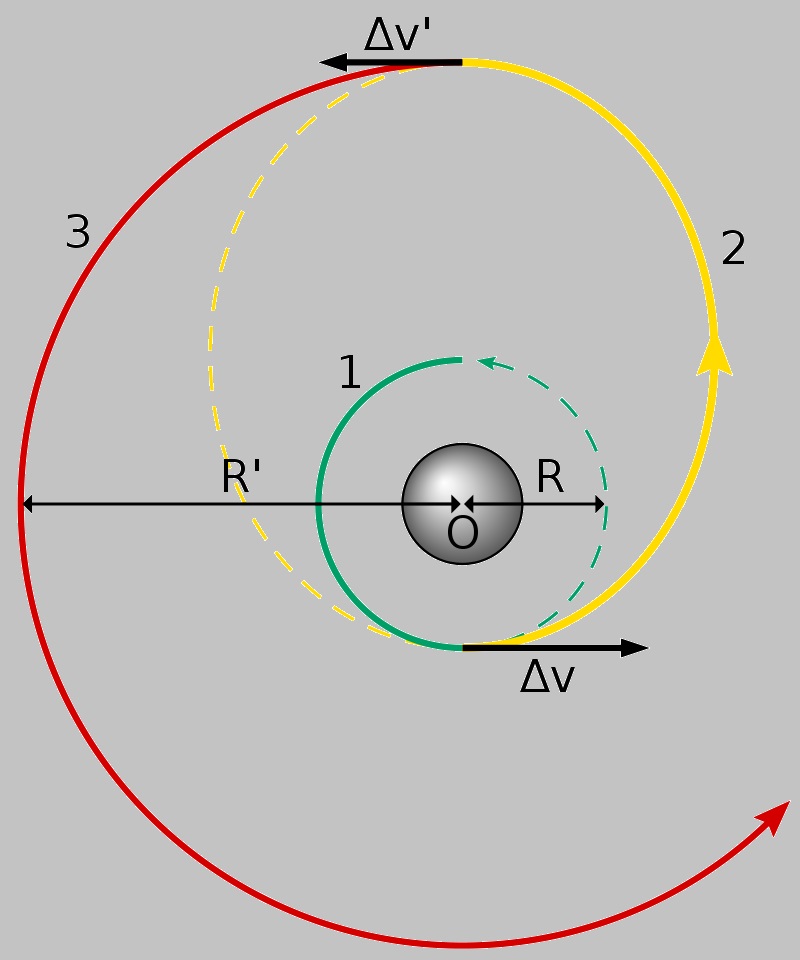 1.39 km / s at the peak of
1.39 km / s at the peak of
It is therefore
The speed boost will be provided by a rocket
engine installed on the satellite and directing its jet towards the rear of its
course, and creating a thrust forwards.
Hohmann transfer
orbit
A trajectory (also called transfer) of Hohmann is a trajectory that allows to go
from a low circular orbit to another higher circular orbit located in the same
plane, using only two impulse manoeuvers. By limiting
itself to two manoeuvers, this trajectory is the
trajectory consuming as little energy as possible
Whether
losing a certain amount of speed or gaining it, whether the transfer is
negative or positive, the satellite's manoeuvering
rockets have exactly the same energy to develop.

.
Placement
into geostationary orbit GTO
Telecommunication satellites (satellite television) are placed in a geostationary
transfer orbit (GTO). It is an elliptical orbit, with an apogee at
The rocket propels the satellite to
Fuel is reserved to correct changes in the orbit by solar winds. The
circularization motor is always the one that then performs the corrections.
The correction system must be liquid propellant because it must be
turned on a large number of times). When he runs out of fuel, he is out of
order.
To avoid cluttering the orbit, the newer use their last fuel reserves to
deviate.
The lifespan of a geo satellite is 10 to 15 years.
But if the shot is made from a site far from the equator, you have to do
more detours. If you shoot from a center far away
from the equator, the satellite must use a large amount of fuel to make a
"turn". Its life is diminished.
There is no difference between the launching of an inhabited ship and
that of an ordinary satellite, except for a difference in weight and accuracy.
Back
to earth
The manned space ship, to return to earth performs maneuvers.
Unlike the launch, if we reduce the circular speed, the satellite will
shorten its trajectory.
At
An inhabited ship must be designed on the contrary not to be destroyed.
Return to the atmosphere consists of a braking out of the atmosphere,
and a braking in the atmosphere and a stabilization of the vessel.
The orbit on which the inhabited ship is travelling is determined by its
speed of orbiting.
The voluntary slowdown must be obtained by a reaction system, by a
rocket ejecting gases
It is necessary that the rocket is directed forward
"retro-rocket".
At
The energy capable of slowing down a satellite by
According to Tsiolkovsky's equation: Δv = ve ln m0 / m1 -gT.
This gives, with gases at
Factors to consider:
-The details of the moment of ignition
-The direction of the jet of the retrorocket exactly in the direction of
the race of the satellite.
To stabilize a vessel in airless space, the only way is to react.
It is necessary to act small rockets throwing their gas in the direction of the
gyratory movements.
The mechanism of stabilization will consist of a set of small rockets
arranged around the vessel and able to take action each in isolation in a given
direction, according to the direction of the spinning and with the necessary
force.
It is a gyroscopic system, with 3 degrees of
freedom, which will guide the ship in space.
The ship
will enter the atmosphere at a speed greater than 7km / s (
- slowing
down of the machine
- heating
of the vessel by impact effect.
At this
speed, the energy to be developed is enormous both in kinetic form due to speed
and in potential form due to altitude.
The ideal
would be a powerful braking (thus very consumer) before the arrival in the
layers of the atmosphere then a vertical descent under parachute, but too
energy consuming. We will use the drag of the machine in the atmosphere to slow
it down. But we'll have to protect the ship from the heat.
There are
two major classes of solutions. In the first this function is performed by an
insulator placed under the surface material. In the second, it is the surface
material itself.
Large orbiter-like returning objects of the space shuttle are
subject to relatively modest environmental conditions, at least when compared
to that of the space probes. Indeed the need to obtain low accelerations for
human flight is accompanied by obtaining moderate heat flux. Hence the design
of manoeuvering objects capable of large incidences
at high altitude and thus a significant braking in the low-density slices of
the atmosphere.
Reusable thermal
protection
To obtain this result, the thermal operation is therefore based on the
re-emission of a large part of the incident energy, obtained by a surface of
high emissivity and on a material of low thermal conductivity.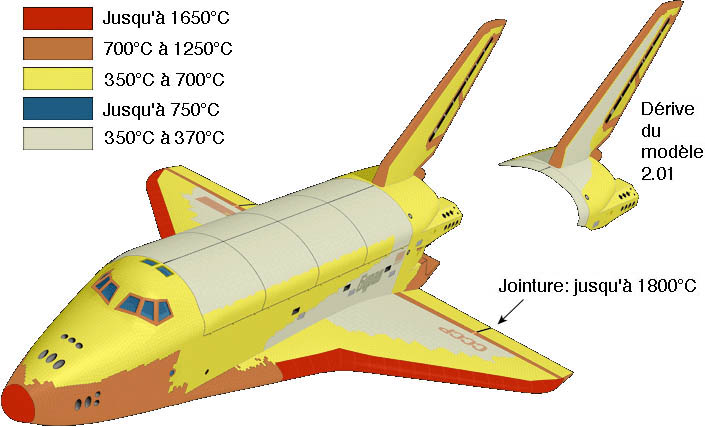
There are three types of regions:
-The front tip and the leading edges of the wings
that support the most severe environmental conditions. A carbon-carbon material
having a density of
-The lower wind portion at the entrance
consists of high-temperature Reusable Surface Insulation (HRSI) tiles
comprising a structure formed of porous silica fibers
(porosity 94%) surmounted by a borosilicate layer comprising an additive
intended for increase the emissivity of the surface, hence its black
appearance. The density is
-Least exposed parts are protected by
Low-temperature Reusable Surface Insulation (LRSI) tiles similar to HRSI but
with an aluminum oxide deposit that gives it a white color. They are qualified for use up to 900 K. They also
participate in the thermal regulation in orbit, it is
for this reason that one has chosen a surface having a high reflectivity thus a
low emissivity.
Other insulators of lower performance are used
locally. In total the thermal protection represents 10% of the total mass of
the orbiter.
Given the complexity of the outer surface of a
shuttle the thermal protection is cut into a large number of tiles (20 548
tiles on the space shuttle, 38 600 on Buran2). This leads to a complex
technical management but also to an important problem constituted by the
junction between two tiles. It is indeed necessary to reconcile the expansion
with that of the entry of the hot gases in the interstice between two tiles.
Ablative systems
ex PICA Thermal Shield from the Mars Science
Laboratory.
The heat shields used for space probes undergo
a much more severe environment than that of the space shuttle. The maximum heat
flux is in MW / m2: 5 for Apollo 4, 11 for Stardust, the most severe landfall
ever made and up to 350 for Galileo
The actual value depends on the material
through the parietal temperature and the phenomenon of injection of gases from
physical or chemical decomposition and will oppose the convection of hot gases
in the boundary layer.
This phenomenon reduces the heat flow but also
the transfer of gases to the wall, in particular that of oxygen when it is
present